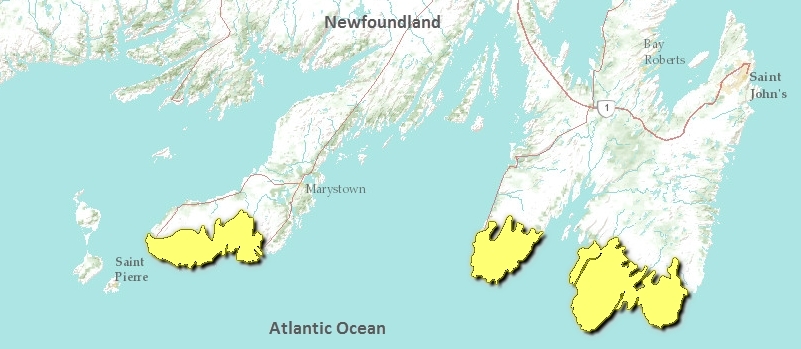South Avalon-Burin oceanic barrens
This small ecoregion is comprised of the outer headlands of narrow peninsulas in eastern Newfoundland. These headlands are exposed to high winds, cool temperatures and salt spray for most of the year.
The ecoregion is classified as having an exposed oceanic low boreal ecoclimate. Mean annual temperature is approximately 5.5°C. Summers are cool, with a mean temperature of 11.5° C, and foggy. Winters tend to be short and relatively mild, with a mean temperature of -1° C. Mean annual precipitation ranges between 1200-1500 millimeters (mm).
 This ecoregion is underlain predominantly by a mixture of late Precambrian sedimentary and volcanic strata, and its elevations rise abruptly from the sea to about 200 meters (m) above seal level (asl). Stream erosion has cut deeply, and the uplands are dissected, rugged, and rocky along the coastline, but inland they present a rolling terrain of low relief. The surface of the uplands is dominated by peat-covered, rolling to hummocky, sandy morainal deposits with sloped that range 5-30 percent. Surficial deposits of glacial till are common, and wetlands cover more than 25 percent of the ecoregion. Precambrian fossils have been found at Mistaken Point Ecological Reserve.
This ecoregion is underlain predominantly by a mixture of late Precambrian sedimentary and volcanic strata, and its elevations rise abruptly from the sea to about 200 meters (m) above seal level (asl). Stream erosion has cut deeply, and the uplands are dissected, rugged, and rocky along the coastline, but inland they present a rolling terrain of low relief. The surface of the uplands is dominated by peat-covered, rolling to hummocky, sandy morainal deposits with sloped that range 5-30 percent. Surficial deposits of glacial till are common, and wetlands cover more than 25 percent of the ecoregion. Precambrian fossils have been found at Mistaken Point Ecological Reserve.
Biological Distinctiveness
The moss-heath plant associations of this ecoregion, dominated by blanket bogs and Racomitrium heath, are unique to North America. Its closest affinities are in oceanic climates such as Iceland, Northern Scotland, and Spitzbergen.
The ecoregion supports dense carpets of moss and fruticose lichen, along with closed, low-growing ericaceous shrubs. Dwarf krummholz of balsam fir (Abies balsamea) occurs on some upland sites, and the moss-heath of this region is unique to North America.
Characteristic wildlife include caribou (Rangifer tarandus), willow ptarmigan (Lagopus lagopus), and many seabird species, including one of the world’s largest Northern gannet (Morus bassanus) colonies, situated at Cape St. Mary’s.
Conservation Status
Habitat Loss and Degradation
It is estimated that 95 percent of this small ecoregion remains intact. Some habitat loss has occurred due to the presence of a few very small coastal communities and associated access roads.
Remaining Blocks of Intact Habitat
The ecoregion is naturally disjunct, and each area could be considered as a separate habitat block.
Degree of Fragmentation
Very minor habitat fragmentation.
Degree of Protection
- Chance Cove Provincial Park - southeastern Newfoundland - 20.68 km2
- Cape St. Mary’s Ecological Reserve - southeastern Newfoundland- 13.10 km2
- Mistaken Point Ecological Reserve - southeastern Newfoundland - 2.95 km2
- Holyrood Pond Provincial Park - southeastern Newfoundland - 2.26 km2
Types and Severity of Threats
The greatest threat is from All Terrain Vehicles (ATV’s) in the lowlands. Recreation activities around the seabird colonies will require careful management. Caribou poaching is a problem in this area.
Suite of Priority Activities to Enhance Biodiversity Conservation
- The existing protected areas in this ecoregion are not yet large enough to capture the landscape level patterns unique to this area. Priority sites for protected status include the St. Shotts area of the Avalon Peninsula.
- Control ATV traffic into parts of this ecoregion.
Conservation Partners
- Action: Environment
- Natural History Society of Newfoundland and Labrador
- Newfoundland/Labrador Environmental Association
- Protected Areas Association of Newfoundland and Labrador
- World Wildlife Fund Canada
| Disclaimer: This article is taken wholly from, or contains information that was originally published by, the World Wildlife Fund. Topic editors and authors for the Encyclopedia of Earth may have edited its content or added new information. The use of information from the World Wildlife Fund should not be construed as support for or endorsement by that organization for any new information added by EoE personnel, or for any editing of the original content. |

